Allergies on the face occur much more often than on other parts of the body when it comes to skin hypersensitivity. It can appear on different areas of the skin, causing discomfort and aesthetic problems.
Facial allergies in adults - causes
Allergic dermatitis on the face can occur due to many factors. The first symptoms, such as itching and rash, are rather abstract in nature and cannot indicate with absolute certainty the source of the reaction.
Therefore, if an allergy appears on the face, its causes are difficult to determine without appropriate research.
Food allergies
Food allergic dermatosis is most often triggered by protein foods.
The most common allergens:
Symptoms typically appear anywhere from a couple of minutes to two hours after eating the food. In severe cases, they can even appear from the smell of the product. With hypersensitivity to certain products, an allergy may appear on the cheeks in the form of swelling, itching and hives.
More dangerous consequences may include swelling of the mucous membrane, anaphylactic shock and loss of consciousness. The most effective treatment method in this case will be a complete abstinence from foods that cause an allergic reaction.
Contact allergy
This type of allergic dermatitis occurs when there is contact with an irritant that causes a response.
What can cause contact irritation:
- Plants - for example, allergic dermatosis may appear due to a face cream if it contains herbs;
- Metals — the most allergenic are those contained in stainless steel;
- Preservatives and stabilizers — contained in cosmetic preparations;
The lesion manifests itself in young and middle ages and is much less common in children. Exposure to an allergen can manifest itself in facial redness, itching, flaking and dry skin; in more severe cases, fever, migraines and chills occur.
Allergy to physical impact
An allergic rash on the face can be caused by physical exposure, this could be:
- cold - Cold allergies on the face usually look like hives and are accompanied by a runny nose.
- sunlight;
- pressure;
- elevated temperature - Sensitivity to heat is accompanied by increased sweating.
- water and etc.
Allergic rashes can appear not only as a rash, but also as red, itchy spots and blisters.
Allergy to insect bites
Angioedema and cheek allergies can be a symptom of increased sensitivity to insect bites. Once this type of allergic reaction occurs, it will most likely never go away. Its danger lies in the fact that it appears on the face not only in the form of dermatitis.
Insect poison and mica can cause Quincke's edema, which, in the absence of urgent measures, leads to rapid death from suffocation.
Symptoms of the disease:
- Local - occur only at the site of the bite - burning, itching, pain, swelling, redness and induration.
- Generalized - hives, runny nose, general weakness, difficulty breathing, fainting and low blood pressure.
Other reasons
- Environmental problems and air pollution can lead to an increased immune response to irritants.
- Hereditary pathology.
- Consumption of semi-finished products and exotic products previously unknown to the body.
- Frequent moves and adaptation to new climatic conditions, new infectious and nutritional environmental factors can force the immune system to work at its maximum and manifest itself in the form of dermatitis.
- Excessive use of hygiene products, which destroys the microflora of the dermis.
Manifestations of human allergies
Types of allergies on the face:
- Allergy on the face in the form of red spots (erythema) - most often in this case the cause is food, cold and cosmetics containing an allergen.
- Rash (papules, pustules, blisters, vesicles) - occur with urticaria, insect bites, contact and atopic dermatitis.
- Red cheeks — allergies of this kind most often occur in young children after introducing a feeding mixture into the diet; reducing its concentration, as a rule, solves the problem.
- Swelling on the face from allergies (Quincke's edema) is one of the most universal and dangerous symptoms; it can be caused by drug allergies, foods, pollen, wool and much more. It manifests itself very quickly and, in the absence of immediate intervention, can spread to the throat and lead to suffocation and death.
- Scabs, scales, erosions and eczema - secondary types of rash that appear with prolonged absence of treatment or a chronic form of autoimmune reaction.
- Other manifestations - hives, cough, sneezing, pain in the eyes and runny nose.
Dependence of symptoms on localization
- Rash on lips and mouth area - a sign of an allergy to cold; redness, peeling, itching and swelling may also appear on the face.
- Allergy on the cheeks often expressed as red spots - indicates contact dermatitis caused by cosmetics and other external influences.
- Allergy on the chin may occur due to many allergens (cosmetics, wool, medications, insect bites, food, etc.). Most often expressed as a red rash.
- The appearance of allergies on the face and neck can be triggered by the metals from which jewelry is made, parasites and other allergens listed above. First, redness appears, and as contact with the allergen continues, it turns into a rash that begins to peel off.
How to get rid of allergies on the face?
The appearance of allergic symptoms can be easily eliminated by stopping contact with the original allergen. However, if this is not possible, medicines and folk remedies will come to the rescue. Remember that treatment can only be prescribed by a doctor, otherwise the situation can only worsen.
General principles of therapy include:
- Maintaining immunity;
- Blood cleansing;
- Antihistamines and symptom-relieving drugs.
Drug therapy
When treating allergies on the face, treatment is divided into 2 types:
- Etiopathogenetic - impact on the cause;
- Symptomatic - effect on symptoms.
The doctor decides how to treat allergic dermatosis on the face, based on its type.
Tablets for allergic dermatosis on the skin:
- Antihistamine tablets help in many cases, including even allergies to cold on the face.
- Tavegil - 180 - 250 rubles;
- Zyrtec - 200 - 390 rubles;
- Claritin - 230-250 rub.
- Sorbents used for food allergic reactions, they treat its manifestations in the stomach and intestines, and after them the rashes on the face also disappear.
- Enterosgel - 390 - 470 rubles;
- Smecta - 150 - 410 rubles;
- Polysorb - 260 - 290 rub.
What to put on your face if you have allergies?
Ointments are used in conjunction with oral antihistamines. They complement treatment and promote rapid relief and relief of acute symptoms before important events or severe discomfort.
Non-hormonal ointments for allergies on the face
Facial skin allergies may require ongoing treatment; in this case, it is better to use non-hormonal medications - they are much safer. But even they should be used only after consulting a doctor.
- Fenistil - antihistamine cream for allergies on the face, carefully used 2-4 times a day, price - 400 rubles.
- Psilo-Balm - an antihistamine, applied 3-4 times a day, helps well against allergic edema, price - 250 rubles.
- Radevit Active - healing ointment for facial allergies in adults, rubbed twice a day. If there is an open wound (cracks, severe scratching, etc.), the area should be pre-treated with an antiseptic. The duration of use is unlimited, the price is 370 rubles.
Hormonal ointments for allergies on the face
Hormonal creams for allergies on the skin of the face are considered the most effective and are used when other creams do not help. They influence the inflammatory process and slow down the process of cell destruction.
However, hormonal ointments for allergies on the face cannot be used for a long period and during infectious diseases, because they can suppress the immune system and have a systemic effect. Under no circumstances should you apply hormonal ointments without a prescription from an allergist.
- Hydrocortisone ointment — applied 2-3 times a day, do not apply to steamed skin to reduce the penetration of the product into the blood. Price - 30-40 rubles.
- Elokom - used once a day, price - 200 - 360 rubles.
- Gistan - course duration - 1 - 4 weeks, has additional antipruritic and anti-inflammatory effects, should not be used during pregnancy, price - 170 rubles.
Therapy with folk remedies
In addition to the use of medications, the use of folk remedies is quite often practiced. Some recipes should not be used on particularly sensitive areas of the skin - near the eyes, lips, mucous membranes. Another thing is allergies on the chin, cheeks and other places where the skin is not so sensitive.
If after alternative therapy the condition worsens, treatment should be stopped immediately.
- Decoction recipes:
- Bay leaf Boil in a small amount of water and leave until cool. The decoction relieves itching and redness; it can be used to treat allergic spots on the face in children, and can be taken orally by adults.
- Grass succession against allergies on the face - can also be taken orally and externally. The recipe is the same as the previous one and relieves even very severe itching.
- Collection of herbs for the treatment of allergies on the face (rose hips, St. John's wort, centaury, dandelion root, corn silk and horsetail) can be found at the pharmacy or collected independently. Place the herbs in a thermos, pour boiling water over them and leave for 7 hours, strain and take chilled orally.
- Horseradish cream for allergies on the face. Mix a tablespoon of horseradish juice with the same amount of sour cream and leave for 1-2 days. Apply the cream to a clean face before going to bed no more than 2-3 times. The mixture helps cure allergies and acne.
- Peppermint ointment. Pour 2 tablespoons of dry mint with the same amount of boiling water, mix well and let cool. To get rid of an allergic reaction on the face, apply the ointment 1-2 times a day for 20 minutes. This folk remedy for facial allergies relieves itching, erythema and irritation. It can also be used if you are worried about allergies on your chin.
- Mustard ointment for allergies on the face. Mix one tablespoon of mustard powder with just boiled water to a thick consistency. Apply to skin before bed. You should be careful with this recipe, sometimes it can only increase the itching on the face. It may be suitable for minor chin rashes in women.
Hypoallergenic diet
The basic principle of hypoallergenic nutrition is the exclusion from the diet of foods that may be a potential cause of allergic red spots on the face.
How to remove signs of an allergic reaction with nutrition:
- Seafood should be excluded, processed dairy products, smoked and pickled foods, seasonings, coffee, red and orange vegetables and fruits, cheese, eggs, dried fruits, mushrooms and sweets.
- You can eat dairy products, lean meat and fish, porridge with water, green vegetables and fruits, dry cookies and bread.
- Nutrition should be balanced and contain the necessary set of dietary fats (proteins, fats and carbohydrates) and calories for the normal functioning of the body.
- Divide meals into 5-6 times a day, in this way you can relieve the burden on the digestive tract and increase the digestibility of foods.
- It is better to steam foods or eat boiled.
- Frequent fluid intake - an effective method of cleansing the body and removing allergens.
Follow this diet for 2-3 weeks, then gradually add new products; when an allergic reaction appears again with the introduction of a product, we can conclude that it is the cause.
There is an easier way - you can contact an allergist who will conduct the necessary research and identify the allergen.
Allergy prevention
The best way to prevent it is to avoid contact with the allergen:
- For food autoimmune reactions (most often if an allergy rash appears on the cheeks) - it is necessary to exclude highly allergenic foods.
- For allergies due to nerves - avoid stress.
- Contact allergic reaction involves avoiding the use of soaps and other hygiene products with aromatic fragrances, cosmetics and metals and other allergens, after exposure to which irritation may occur.
Do wet cleaning at home more often, protect your skin from the sun, and in case of any complications, contact an allergist-immunologist.
Cold allergy is one of many types of negative responses of the body to various external stimuli. The very name of this allergy suggests that an allergic reaction occurs under the influence of cold temperatures.
Until recently, medicine rejected such a diagnosis, since there is no allergen that provokes a specific reaction of the body as such, there is only a physical effect - cold. No allergen means no allergies.
But when exposed to cold air, some sensitive people experience a significant release of histamine, which causes reactions similar to other types of allergies - the development of swelling, vasodilation, redness and itching of the skin and mucous membranes. This is a response to a decrease in the temperature of the skin's thermal receptors.
Causes of cold allergies
Why does cold allergy occur? Medicine does not yet know the exact answer to this question, but with the following factors, particularly sensitive people may experience this strange type of allergy:
- When there is a sharp change in a person’s presence in an environment with normal air temperature to an environment with low temperature - in winter, especially in windy weather
- In contact with cold water - in everyday life when washing dishes, cleaning, swimming in open water
- When drinking very cold drinks or cold food
Allergy to cold often develops after severe illness and long-term treatment with antibiotics; it is believed that it has a genetic predisposition; it can occur against the background of infectious diseases (for example, tuberculosis) or parasitic diseases (roundworms in children, adults, pinworms in children, giardiasis. 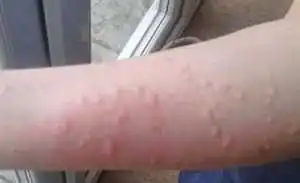
In a strong, hardened organism with a strong immune system, such temperature changes do not cause any reactions.
However, in the event of a decrease in protective forces, systemic disorders, serious illnesses, or metabolic disorders in the body, this type of allergy may occur. Stress, as we know, is the most important risk factor for immune failure, so stress-resistant people tend to get sick less often and have good health.
Provoking factors for the development of cold allergies
- The presence of allergic reactions to other irritants - food, pollen (allergy to poplar fluff), household allergies
- Some infectious diseases - mumps, measles (see symptoms of measles in adults), mycoplasma pneumonia, rubella
- Thyroid diseases, systemic lupus erythematosus, cancer
- The presence of chronic diseases - sinusitis, sinusitis, various worm infections, intestinal dysbiosis
- Recurrent skin diseases – neurodermatitis, eczema, psoriasis
- Hereditary factor
There are cases when such a reaction is hereditary in nature, that is, it is inherited and most often it is the body’s reaction to windy weather than to cold. The symptom of such an allergy is a burning sensation, not itching of the skin.
How does an allergy to cold manifest itself?
How does an allergy to cold manifest itself? Symptoms of such an allergy can have various forms of manifestation - from mild symptoms that disappear some time after contact with a cold environment, to serious recurrent skin rashes.
Skin manifestations are the most common signs. These include redness, swelling, itching of open areas of the body that have come into contact with a cold environment. After some time, the skin begins to hurt, itch, and may become blistered, similar to hives.
Cold allergies in children can even affect the inner surface of the legs, thighs, knees and manifest themselves in the form of hives. The rash is pink, dense, itchy, but goes away within a few hours. There are cases when, after a cold, the skin not only turns red and itches, but also becomes covered with a layer that begins to peel off, as with dermatitis. Sometimes bruises appear at the site of the allergy over time.
Most often, cold allergies occur on the face and hands, since these places are more exposed to the external environment, they are always open and more vulnerable.
General malaise - increased blood pressure, shortness of breath, headache and weakness.
Allergic rhinitis - the appearance of a runny nose, sneezing when going out into cold air. Swelling of the mucous membranes of the nose can either greatly complicate nasal breathing or completely block it, and upon returning to a warm room, all allergy symptoms disappear.
Signs of allergic conjunctivitis are tearing, swelling around the eyes, swelling of the eyelids, pain in the eyes. Hypersensitivity to bright light also occurs. To differentiate the diagnosis, you should definitely consult an ophthalmologist and dermatologist, since if profuse lacrimation occurs in the cold, this may be a sign of tick-borne infection (demodex) or fungus, etc.
Diagnosis of cold allergies
If you experience similar symptoms, then first of all you need to visit a therapist and an immunologist - an allergist. After a set of diagnostic and laboratory tests, it will be possible to accurately determine the cause of the allergic reaction. Cold allergies, the symptoms of which are similar to other types of allergic reactions, should be differentiated from a number of other diseases.
- Sometimes in small children of preschool age, cold allergies on the face are similar to atopic dermatitis, neurodermatitis.

- Often similar allergic symptoms occur with idiopathic dermatosis. With this disease, heat and cold skin receptors are deregulated. Swelling, lacrimation, sneezing, and difficulty breathing occur in both cold and heat.
- Intolerance to the fur of some animals - rabbits, mink, chinchillas, woolen fabrics, sheep's wool - can also be confused with an allergy to cold. When putting on clothes and going out into the cold, a person returns with a rash and swelling of the nasopharynx; as a result, this can be assessed as a reaction to the cold, and not an allergy to wool or fur.
- The situation is similar with perfume products. Typically, perfume is applied to the forearm, neck, face, and an allergic rash can be caused by cosmetics and perfumes, and not by cold.
When symptoms appear, it is important to make a correct diagnosis, and only after differentiating the signs of allergy can a doctor confirm this disease. Then, the question arises: is an allergy to cold treatable?
How to treat allergies to cold
The inability to eliminate an allergen such as cold makes the fight against such an illness quite difficult. If the patient is diagnosed with an allergy to cold, treatment in this case is purely symptomatic. It is only possible with the help of antihistamines to slightly reduce its manifestations, or to protect exposed areas of the body as much as possible from exposure to negative temperatures. You can reduce the occurrence of allergic reactions if:
- Before going out into the cold, lubricate your face and hands with baby cream, for adults, with any rich cream. Lips should be lubricated with hygienic lipstick. This will partially protect uncovered areas of skin from cold air.
- Badger fat has a very good effect; it is rich in unsaturated fatty acids and vitamins B and A, which have only a positive effect on the skin. 20 minutes before going out into the cold, you can lubricate exposed areas of the skin with badger fat (lips, cheeks, nose, hands); if there is no serious liver damage, then you can consume it orally 40 minutes before. before breakfast, 1 tbsp. a spoonful of fat.
- Long warm gloves, preferably waterproof mittens for children, warm scarves, it is preferable to have hoods in outerwear - this will effectively protect from the wind and better retain heat.
- Medicinal herbs, if there is no allergy to them, can also help with the development of urticaria, which appears as an allergy to cold. Burdock root, tricolor violet and walnut leaves are very useful. To collect, mix the raw materials in equal proportions, 2 s. Pour a tablespoon of the mixture into a glass of boiling water, leave for 1 hour, strain, consume the resulting broth 60 ml 3 times a day.
- Pine cones (see pine cones for stroke) or spruce cones also have beneficial properties; 4 cones are required to prepare the decoction; they should be ground in a mill or meat grinder, poured with water and simmered over low heat for half an hour. After straining the broth, you can wipe it on chapped and rough skin every evening.
- If you have a cold allergy, the symptoms of which are minor, then gradual hardening and rubbing can strengthen the immune system and reduce the body's reaction. But for young children and people with intense symptoms, hardening is contraindicated, as it is fraught with the development of complications in the form of anaphylactic shock, Quincke's edema, and laryngeal edema.
- During the cold season, you can use antihistamines (A complete list of all allergy pills is in our article.)
| A drug | Price, rub.) | |
| Antihistamines in tablets | Tavegil | 170-250 |
| Zyrtec | 250-300 | |
| Zodak | 130-200 | |
| Tsetrin | 160-240 | |
| Claritin | 180-240 | |
| Suprastin | 120-140 | |
| Levocetrizine | 170-300 | |
| Cetirizine | 90-100 | |
| Fexofast | 160-200 | |
| Parlazin | 130-140 | |
| Antihistamines creams, ointments (ointments for dermatitis) | Skin cap, Gistan N contains a hormonal substance (list of all hormonal creams and ointments) | 150-160 |
| Gistan, La-kri - contain extracts of medicinal herbs, use it if you are not allergic to them | 170-190 | |
| Auxiliary products for skin irritation | Panthenol spray and cream foam | 200-300 |
| Dexpanthenol cream | 140 | |
| Bepanten | 470 | |
| Antihistamine drops in the nose (For rhinitis from the cold, 20 minutes before going out into the cold) | Allergodil | 280-300 |
| Fenistil | 280-300 | |
| Parlazin | 280-300 |
Rashes on the face and red spots in the winter season are the cause of cold allergies. Experts believe that cold cannot be an allergen, being a physical factor. This name was invented by the people, and then became a generally accepted definition. However, such a reaction of the body is still being studied and in any case requires treatment.
What is cold allergy
Cold allergy is a feature of the body that manifests itself in people who cannot tolerate low temperatures. At the initial stage, the pathology manifests itself in the form of redness or rash with an itching sensation. A person cannot always distinguish cold allergies from skin diseases.
Occurs for the following reasons:
- when outdoors at low temperatures, especially in the presence of wind;
- when touching a cold object (snow, ice, ice water);
- when drinking a very chilled drink.
Cold allergies on the face and other parts of the body are considered one of the manifestations of urticaria, since local changes in the skin similar to this pathology occur. However, this disease should not be underestimated, since it can cause severe disruptions in the human body and become chronic.
This pathology can be either hereditary or acquired. The acquired form often occurs in adulthood, and the hereditary form can occur even in newborns.
The effect of the disease on the body
Most often, such a reaction occurs in people with high sensitivity of skin receptors and nerve centers.
Cold allergies can affect the body in different ways, depending on the type of reaction to low temperature. Pathology in acute or chronic form affects not only the face, but also the entire body, worsening a person’s well-being, which can last up to several weeks.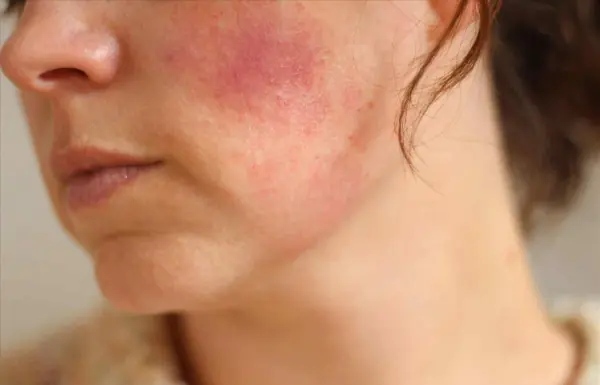
In addition to external manifestations that bring discomfort, pain in muscles and joints, rapid heartbeat, and low blood pressure may appear. Parts of the body may become flaky and swollen.
In a mild form, the allergy manifests itself in the form of redness and itching in areas of the body that have been in contact with frost and wind. When the action of external factors stops, after a short time the skin returns to its normal state. This pathology in a mild form may include lacrimation and nasal congestion, if these symptoms only bother you in the wind and frost.
Causes of cold allergies
The manifestation of this pathology is associated with several reasons, but the pathogenesis has not yet been fully studied; it continues to be studied.
The connection between this reaction to cold and several factors has been determined:
- There are special protein compounds in the body called cryoglobulin. These compounds provoke the release of histamine, which regulates the body's response to physical and allergenic factors.
- Increased production of acetylcholine in the body and excessive susceptibility of cells to it.
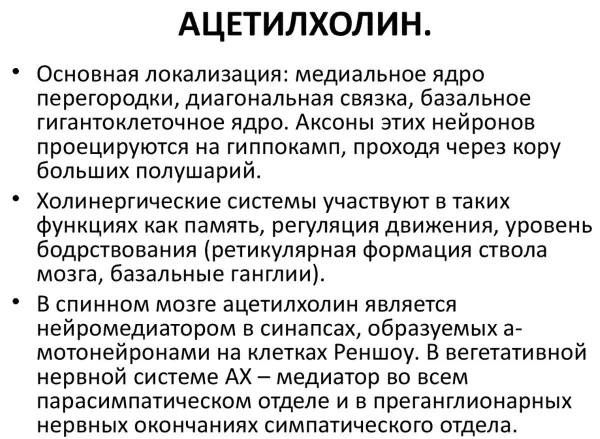
- In the hereditary form, a mutation of a specific gene may occur. This results in the release of a protein that stimulates the inflammatory response.
- Weak immunity and the presence of infectious diseases can provoke symptoms of cold allergies.
Cold allergies on the face or other areas can signal a malfunction in the body; if sudden signs of this illness appear, you should seek medical help.
Symptoms of cold allergy
The disease can manifest itself as one symptom or several as part of one pathological process. By certain signs and timing of the reaction, it is possible to distinguish cold allergies from other diseases that have a similar clinical picture.
An allergy to cold can manifest itself with the following symptoms:
- Redness. Occurs on areas of the skin exposed to low temperatures. Thin skin turns red faster and more intensely than areas with thicker skin. Redness appears especially strongly in areas with damaged skin (wounds and cuts). The manifestation occurs in the form of a pinpoint rash, merging into solid formations of different diameters. After the cessation of exposure to cold, the symptom disappears and the skin acquires a natural color.
- Itching. Appears due to the effect of histamine on nerve endings. Occurs most often after the appearance of redness. The intensity of the symptom may increase. Eating spicy food, physical activity and elevated temperature provoke an increase in the intensity of itching.
- Swelling. Appears in the form of a round formation of pale pink color, protruding above the surface of the skin. After the cessation of exposure to cold, this symptom disappears.
- State of weakness and fever. A sharp rise in temperature (can reach 39-40°C) can become a symptom of cold allergy, especially if accompanied by body aches and headaches.
- Quincke's edema. When reacting to cold, swelling of the lips, eyelids, and mucous membranes may appear. The swelling is compacted and does not leave an indentation when touched with a finger. A dangerous condition is swelling of the neck. Leads to narrowing of the airways and lack of oxygen.
- Dyspnea. Appears due to narrowing of the vocal folds due to swelling, accompanied by a barking cough. Swelling can also spread to the bronchi. A person may panic due to lack of oxygen, and the heart rate increases, which poses a danger for patients with cardiovascular disorders. Oxygen starvation is accompanied by blueing of the affected areas of the skin and mucous membranes. Shortness of breath is life-threatening and requires immediate medical attention.
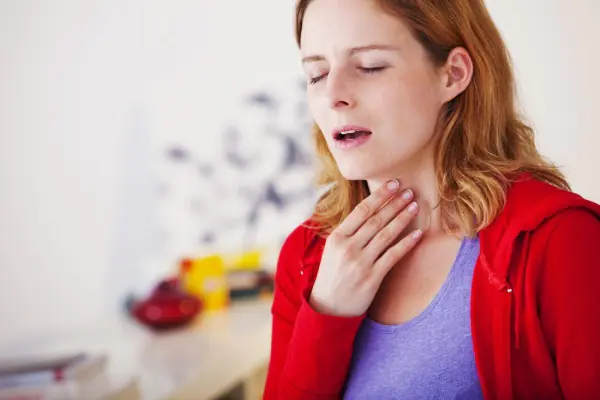
- Dizziness, sensation of tinnitus, nausea, fainting. Similar symptoms occur with low blood pressure due to insufficient oxygen supply to the brain. With acute lack of oxygen in the brain, loss of consciousness may occur. This will be indicated by blue skin. Emergency medical attention required.
Diagnosis of cold allergies
Diagnosis begins with collecting anamnesis. In the process of interviewing the patient, the specialist finds out what the main complaints are, where the manifestations occur and the conditions under which they appear. Lifestyle and diet also affect the clinical picture. After collecting information, an examination and specific appointments begin.
During the diagnostic process, tests are prescribed:
- OAM – an increased level of protein in the urine signals an inflammatory process caused by an allergy.
- UAC — The allergic process is accompanied by an increase in leukocytes, eosinophils and ESR in the blood.
- Blood chemistry. Blood is tested for increases in circulating immune complexes, proteins, and immunoglobulin E levels.
- Skin tests. If the allergen is not detected in the blood, perhaps such a reaction is not an allergy or the reaction is to another substance. Therefore, skin tests are carried out to confirm that it is the cold that provokes the allergy. An example of such tests is the Duncan test. Ice is applied to the inside of the forearm for 3-4 minutes. The ice is in a bag to avoid direct contact with the skin.
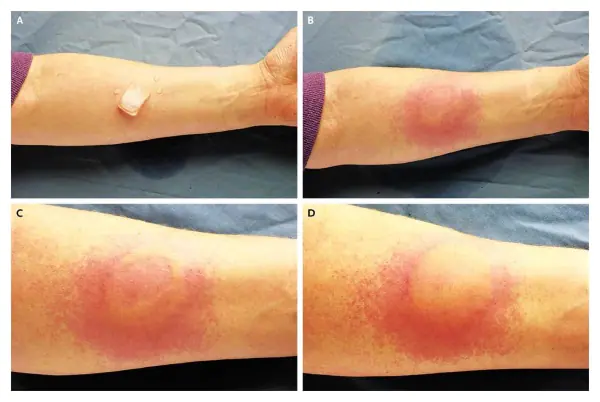
If a person suffers from a cold allergy, then irritation will appear regardless of the face or other parts of the body
After 10-15 minutes. With a cold allergy, a blister appears, the person feels a burning sensation and itching.
Prevention of cold allergies
- First of all, you should take care of protecting your skin with a nourishing cream. Apply in 20-30 minutes. before going out into the frosty air.
- Do not use soap before going out into the cold. It dries the skin and washes away the natural protective film.
- Do not neglect the use of a hat, scarf and tights, mainly of cotton composition.
- When the first signs appear, such as rash and redness, you should immediately go into a warm room.
- Temper the body. The main thing in this procedure is gradualism. If this is a douche, then it is better to start in the summer, gradually reducing the water temperature. In the winter season, if there are symptoms of cold allergies, hardening is not recommended to avoid complications.

- Before the onset of cold weather, take a course of antihistamines and take them throughout the season, in small doses. Such a preventive measure should be prescribed by a doctor.
- Eating hypoallergenic foods.
Which doctor should I contact?
An allergist-immunologist will help identify the allergen through diagnostics and prescribe treatment. Before prescribing examinations, the doctor will need information about the clinical picture, so you should provide all information that is relevant to this disease.
Having completed the survey, the allergist proceeds to examine the skin. In this case, information is important about where on the body the allergy manifests itself most, how quickly it disappears and how it spreads. The doctor will then order a series of tests and may perform an ice test on the surface of the skin.
Treatment methods for cold allergies
1. Drug therapy.
Before prescribing treatment for cold allergies, other diseases should be excluded.
If an allergy to cold is detected, the following medications are prescribed: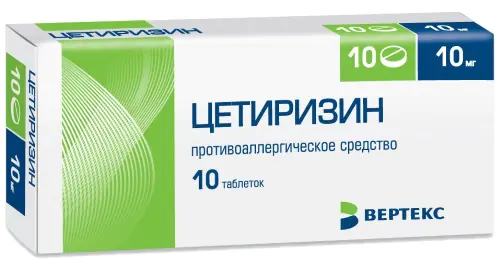
| Antiallergic drugs. |
Action: block histamine receptors. Relieves allergic symptoms.
Claritin Take at any time of the day, regardless of food. Until symptoms subside.1 tablet (10 mg) 1 time per day; children 2-12 years old take syrup - 1 tsp. with a weight up to 30 kg, above 30 kg the dosage should be doubled;
Cetirizine Take in the evening for a week.Adults: 10 mg once; Children 1-12 years old are prescribed drops - 5 drops up to 2 years old, 10 drops from 2 to 6 years old, 20 drops for children over 6 years old.
Suprastinex Take with meals once a day.From 6 years and older – 1 table. or 1 ml drops; children 2-6 years old take 0.5 ml drops, divided into 2 doses.
Corticosteroids.Reduce redness, relieve itching and other objective symptoms.
Advantan is applied once a day in a thin layer to the affected areas of the skin. Use for children from 4 months. It has anti-inflammatory and immunosuppressive effects and is able to penetrate the central nervous system. Prescribed for shock and severe swelling. Dexamethasone The dosage regimen and method of administration are selected individually. Daily dose up to 10-15 mg, divided into 2-3 doses. Hormonal ointments.Used to eliminate rashes.
SinaflanExternally. 1-3 times a day. Bronchodilators.
Prescribed for shortness of breath and blue skin.
Eufillininjections
The dosage regimen is prescribed individually, depending on the indications, age, clinical picture, method and schedule of administration. Salbumatol aerosol From 12 years of age and adults 3 mg 3-4 times a day; 6-12 years 2 mg 3-4 times a day; 2-6 years: 1 mg 2 times a day. Adrenergic agonists.Prescribed for swelling of the mucous membranes, low blood pressure and shock.
Epinephrine 0.1-0.25 mg, diluted in 0.9% sodium chloride, is administered once in a state of shock;children maximum dosage 0.3 mg

2. Traditional methods.
Traditional treatment for cold allergies is mainly aimed at increasing immunity. But we must not forget that some remedies and herbs cause an even greater allergic reaction. Before use, you should definitely consult a specialist.
Here are some methods:
- Chamomile decoction – pour boiling water over the inflorescences and leave in a steam bath for 15 minutes. Cool. Before going out into the cold, lubricate with a cotton swab or wash your face with this decoction.
- Bath with a string – 20 gr. inflorescences per 20 liters of water; Pour hot water over the flowers and simmer over low heat for 10 minutes. Then strain the broth into a bath of water. It will help if allergies appear in other parts of the body, take until symptoms disappear.
- Extracted juice from celery root – take ½ tsp. before meals 3 times a day until symptoms disappear.
- Birch juice – has a general strengthening, anti-inflammatory effect, helps with swelling, you can take up to 1 liter per day during symptoms, as well as for prevention.
- Shilajit solution – 1 g is diluted in 1 liter of boiling water. Take 1 time per day, in the morning. Adults – 100 ml, children – 50 ml.
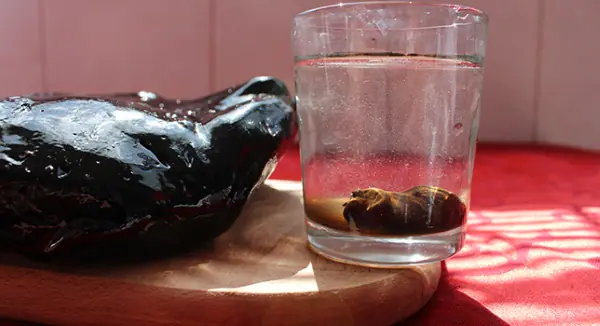
- Raspberry roots - based on 50 g. for 0.5 liters of water. Simmer on the stove for about half an hour, then strain. Take 2 tbsp before going out into cold air and at night. It is advisable to drink it daily for 2 months. before frost sets in.
- Other methods.
Cold allergies on the face and its other manifestations are also treated with homeopathy. The doctor prescribes Viburkol suppositories. Directions for use: from 6 months. 1 candle 4 r. in a day; up to 6 months 1 candle 2 r. in a day. The course of treatment is 5 days.
Complications
Complicated consequences occur most often in the presence of concomitant diseases. If you start the course of the disease without paying attention to its manifestations, this can lead to a deficiency of oxygen in the brain, a sharp drop in pressure to critical levels, after which anaphylactic shock occurs.
It can also occur when a large amount of allergen is released into the circulatory system. The person will be unconscious. Urgent resuscitation is required.
Even people with mild cold allergies experience a deterioration in their quality of life. The face and other parts of the body acquire an unnatural color, and itching occurs at the slightest contact with cold. Severe cases are much less common. However, you should not take the manifestations of this disease lightly in order to avoid complications.
Article format: Mila Friedan
Video about cold allergies
Elena Malysheva will talk about cold allergies:



